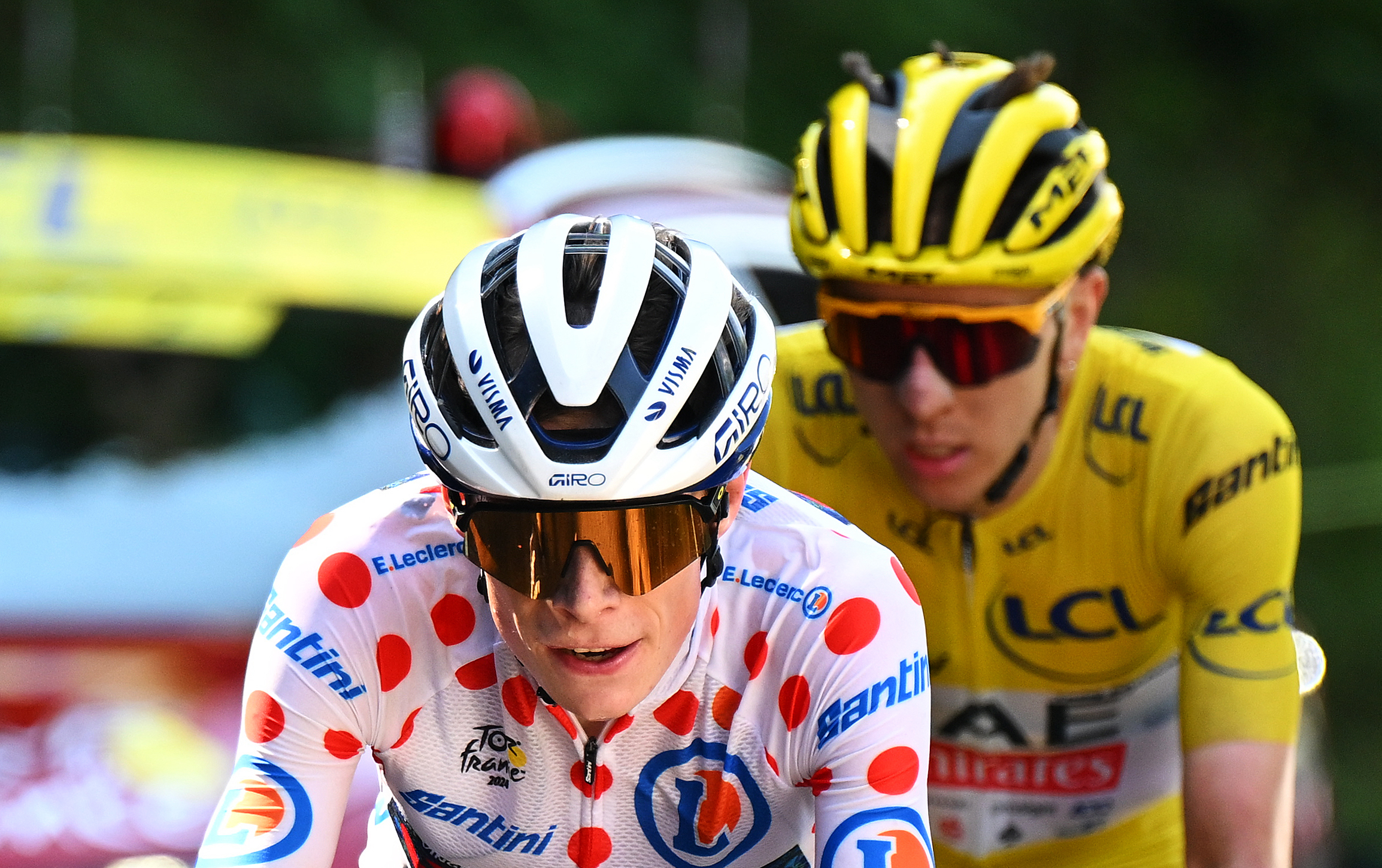
Tadej Pogačar mischievously left room for a little doubt last week when he indicated that he was ‘99%’ certain not to race this year’s Vuelta a España. With the Giro d’Italia already won and the Tour de France firmly under his control, the prospect of a unique Grand Tour treble shimmered like a mirage on the horizon.
However UAE Team Emirates sports manager Matxin Joxean Fernandez firmly dispelled any notion that his charge would line up again in Spain to Cyclingnews. There are limits, even for a rider who wins to such excess.
“Everybody is asking me why we don’t go for the treble. Well, it’s very simple – we’ve had Tadej on the team since he was a young rider, and we’ve always planned with his whole career in mind, not just a single season,” Matxin told Cyclingnews in Nice.
“If you put a rider in three Grand Tours in one season, that also means he would end up racing four Grand Tours in little over a year. We don’t have a short-term vision like that. We don’t just want Tadej to win this year. We want him to keep winning into the future.
“In the rest of this season, Tadej will only race the Olympics, the Canadian races, the Worlds and Il Lombardia. He needs to recover physically and mentally now. So either side of the Olympics, he needs mental peace and a normal life.”
Downtime and training at home was a significant part of UAE’s planning for the 2024 season, when it was decided that Pogačar would make his Giro debut and seek to become only the eighth rider in history to win the maglia rosa and maillot jaune in the same year. He has ridden two Grand Tours but a total of only 52 days of racing.
Pogačar’s second successive defeat to Jonas Vingegaard at the 2023 Tour last year triggered a recalibration and search for improvement.
Although Pogačar finished out his season in typical fashion, winning a third successive Il Lombardia, thoughts were already turning to the new campaign. His switched coach for the first time as a professional, from Iñigo San Millán to Javier Sola, and his racing schedule was also heavily adapted.
Less, it was deduced, could be more. Rather than start racing and winning in February, as he had done throughout his career, Pogačar was instead held back until Strade Bianche on the first weekend in March. It meant that he spent the bones of five months out of competition as he settled into a revised training regimen under Sola. The time away from racing, in essence, allowed for something of a reset.
“Between Il Lombardia and Strade Bianche, Tadej went almost five months without racing, from October to March. That was important,” Matxin said.
“With that time away from racing, he really had this big desire to train hard and then when the season started, he came in fresh and with a lot of hunger.”
That manifested itself immediately, when Pogačar annexed Strade Bianche with an 82 km solo effort, but his racing was still dosed sparingly across the Spring, with UAE adamant that he would have just ten days of competition before the Giro.
Pogačar was third at Milan-San Remo, and then dominated the Volta a Catalunya. That was followed by an altitude camp, the fruits of which carried him to a predictably crushing win at Liège-Bastogne-Liège and onto the Giro.
“In principle, the plan of Tadej not to race too much before the Giro worked well,” Matxin said.
“The idea was not to have too much racing early in the year, and then ride the Giro in a slightly more conservative way.”

Pogačar is better than ever
The men who suffered under Pogačar’s yolk at the Giro will understandably raise their eyebrows at the notion that he raced conservatively in Italy, given that he wore the pink jersey for 20 days, swept to six stage wins and arrived in Rome with a lead just shy of 10 minutes.
It is clear, however, that Pogačar’s already stratospheric level of performance at the Giro was elevated even higher at the Tour.
“Yes, he went up a little bit, the numbers and the data show us that he went up a little bit,” Matxin revealed.
“He recovered very well from the Giro and that race also gave him a lot of race rhythm, and we’ve seen that here.”
In generations past, many of the men who completed the Giro-Tour had a very different experience. Both Jacques Anquetil and Stephen Roche, for instance, both spoke of peaking in Italy and then grinding out the win in France on sheer endurance.
Pogačar, by contrast, somehow seemed to be at his sharpest in July, as testified by the eye-watering power outputs estimated for his wins at Pla d’Adet, Plateau de Beille and Isola 2000. Far from running on fumes by the end of the Tour, Pogačar gave the disquieting impression of having plenty more in the tank, helping himself to the last three stages.
“It’s a different cycling, and even now, it depends on the circumstances of the year,” Matxin pointed out.
“We decided to go for the Giro and Tour this year because this was a good year to do it. There was 11,000m less climbing on the Giro route and there were exactly five weeks between the Giro and the Tour. That allowed Tadej to have a week of rest after the Giro and then three weeks of quality training before he tapered for the Tour.”
The new heights reached by Pogačar on this Tour have generated their own headlines and questions, not least his obliteration of the late Marco Pantani’s tainted record on Plateau de Beille. In the third week, meanwhile, Pogačar’s changed 2024 training regime came into focus thanks to the revival of posts by a mysterious figure called ‘Mou’ that had appeared on the Cyclingnews forum earlier in the year.
“Mou or however you pronounce it, I don’t have an opinion about, because I never read it and I don’t know who he is,” said Matxin, who added that there were limits to comparing climbing times from one generation to the next.
“Journalists pay attention to it, but we never race to beat records from the past. And three riders beat the record at Plateau de Beille, this is simply the cycling of today.
“The riders today are faster, and the equipment is much faster too. I’d invite anyone to try a bike from today and a bike from back then, they would see the difference. And young riders today are much more competitive at an earlier age, you have junior riders with numbers that could make them competitive in WorldTour races.”
And yet, like the three previous summers, two riders were again lightyears ahead of the rest on this Tour. Pogačar and Vingegaard occupied the first two places overall for the fourth July in a row. Despite Remco Evenepoel’s promising Tour debut, there is little indication that this duopoly will recede in the years ahead. Pogačar hasn’t yet turned 26, while Vingegaard is just two years older.
The duel, Matxin suggested, had helped to create the conditions for the double. Like the space race, the pair appear to be pushing one another into new and uncharted territory.
“It’s clear that Tadej is very strong mentally, and I think that the defeats have given him more strength, they made him better,” Matxin said.
“Just like Van Aert and Van der Poel made one another stronger, I think Jonas has made Tadej stronger and Tadej has possibly made Jonas stronger. The rivalry and the closeness of it has made them both more competitive.”
Get unlimited access to all of our coverage of the Tour de France - including breaking news and analysis reported by our journalists on the ground from every stage of the race as it happens and the days following the final classification tabulations. Find out more.







